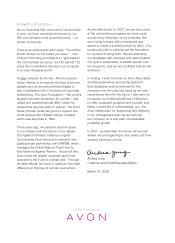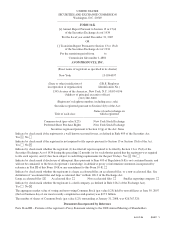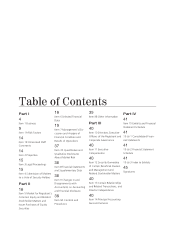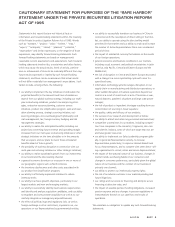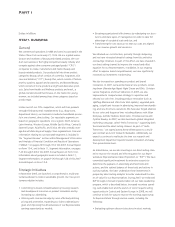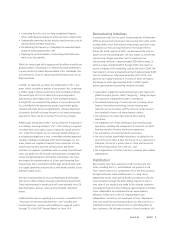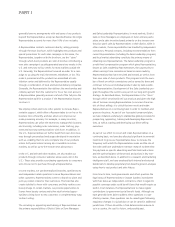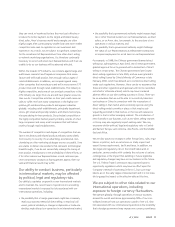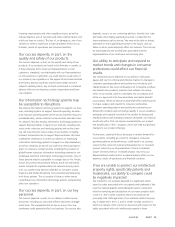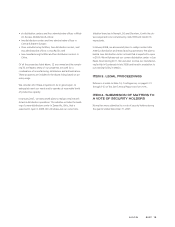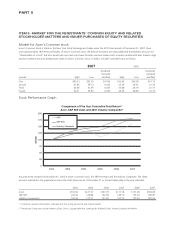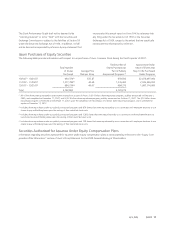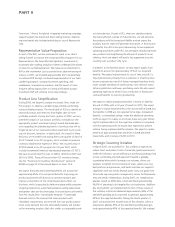Avon 2007 Annual Report Download - page 16
Download and view the complete annual report
Please find page 16 of the 2007 Avon annual report below. You can navigate through the pages in the report by either clicking on the pages listed below, or by using the keyword search tool below to find specific information within the annual report.PART I
• estimate and achieve our projections concerning future rev-
enue and operating margin increases.
There can be no assurance that any of these initiatives will be
successfully and fully executed in the amounts or within the time
periods that we expect.
We may experience difficulties, delays or
unexpected costs in completing our multi-
year turnaround plan, including achieving
the anticipated savings of our multi-year
restructuring initiatives.
In November 2005, we announced a multi-year turnaround plan
as part of a major drive to fuel revenue growth and expand
profit margins, while increasing consumer investments. As part
of the turnaround plan, restructuring initiatives include:
enhancement of organizational effectiveness, implementation of
a global manufacturing strategy through facilities realignment,
additional supply chain efficiencies in the areas of procurement
and distribution and streamlining of transactional and other serv-
ices through outsourcing and moves to low-cost countries. We
may not realize, in full or in part, the anticipated savings from
one or more of these initiatives, and other events and circum-
stances, such as difficulties, delays or unexpected costs, may
occur which could result in our not realizing all or any of the
anticipated savings. If we are unable to realize these savings, our
ability to continue to fund planned advertising, market
intelligence, consumer research and product innovation ini-
tiatives may be adversely affected. In addition, our plans to invest
these savings ahead of future growth means that such costs will
be incurred whether or not we realize these savings. Finally, the
costs to implement the restructuring initiatives are expected to
be approximately $530 million before taxes, of which the Com-
pany has recorded $443.6 through 2007.
We are also subject to the risk of business disruption in con-
nection with our multi-year restructuring plan, which could have
a material adverse effect on our business, financial condition and
operating results.
There can be no assurance that we will be
able to achieve our growth objectives.
There can be no assurance that we will be able to achieve profit-
able growth in the future. In developed markets, such as the U.S.,
we seek to achieve growth in line with that of the overall beauty
market, while in developing and emerging markets we have higher
growth targets. Our growth overall is also subject to the strengths
and weakness of our individual markets, including our international
markets. Our ability to increase revenue and earnings depends on
numerous factors, and there can be no assurance that our current
or future business strategies will lead to such increases.
Our business is conducted worldwide
primarily in one channel, direct selling.
Our business is conducted worldwide, primarily in the direct-
selling channel. Sales are made to the ultimate consumer princi-
pally through 5.4 million independent Representatives
worldwide. There is a high rate of turnover among Representa-
tives, which is a common characteristic of the direct-selling busi-
ness. As a result, in order to maintain our business and grow our
business in the future, we need to retain and recruit Representa-
tives on a continuing basis. If consumers change their purchasing
habits, such as by reducing purchases of beauty and related
products from Representatives or buying beauty and related
products in channels other than in direct selling, this could
reduce our sales and have a material adverse effect on our busi-
ness, financial condition and results of operations. If our com-
petitors establish greater market share in the direct-selling
channel, our business, financial condition and operating results
may be adversely affected. Furthermore, if any government bans
or severely restricts our business method of direct selling, our
business, financial condition and operating results may be
adversely affected.
We face significant competition.
We face competition from competing products in each of our
lines of business, in both the domestic and international markets.
Worldwide, we compete against products sold directly to con-
sumers by other direct-selling and direct-sales companies and
through the Internet, and against products sold through the
mass market and prestige retail channels.
Within the direct selling channel, we compete on a regional,
often country-by-country basis, with our direct-selling com-
petitors. There are also a number of direct-selling companies that
sell product lines similar to ours, some of which also have
worldwide operations and compete with us globally. Unlike most
other beauty companies, we compete within a distinct business
model where providing a compelling earnings opportunity for
our Representatives is as critical as developing and marketing
new and innovative products. Therefore, in contrast to a typical
CPG company which operates within a broad-based consumer
pool, we must first compete for a limited pool of Representatives
before we reach the ultimate consumer.
Direct sellers compete for representative or entrepreneurial talent
by providing a more competitive earnings opportunity or “better
deal” than that offered by the competition. Representatives are
attracted to a direct seller by competitive earnings opportunities,
often through what are commonly known as “field incentives”
in the direct selling industry. Competitors devote substantial
effort to finding out the effectiveness of such incentives so that


